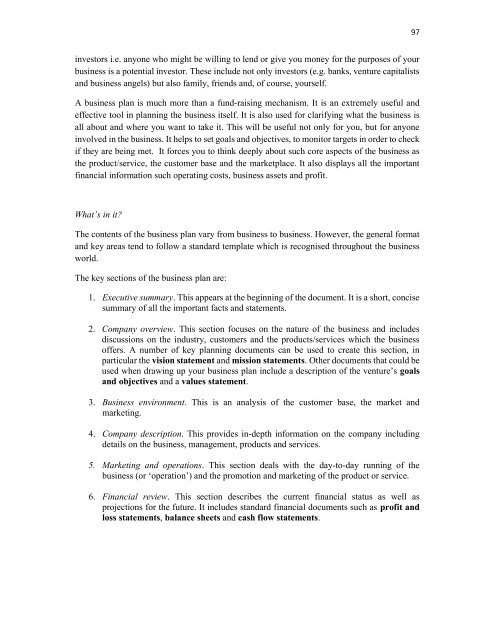and Music
Omega-Book
Omega-Book
You also want an ePaper? Increase the reach of your titles
YUMPU automatically turns print PDFs into web optimized ePapers that Google loves.
97<br />
investors i.e. anyone who might be willing to lend or give you money for the purposes of your<br />
business is a potential investor. These include not only investors (e.g. banks, venture capitalists<br />
<strong>and</strong> business angels) but also family, friends <strong>and</strong>, of course, yourself.<br />
A business plan is much more than a fund-raising mechanism. It is an extremely useful <strong>and</strong><br />
effective tool in planning the business itself. It is also used for clarifying what the business is<br />
all about <strong>and</strong> where you want to take it. This will be useful not only for you, but for anyone<br />
involved in the business. It helps to set goals <strong>and</strong> objectives, to monitor targets in order to check<br />
if they are being met. It forces you to think deeply about such core aspects of the business as<br />
the product/service, the customer base <strong>and</strong> the marketplace. It also displays all the important<br />
financial information such operating costs, business assets <strong>and</strong> profit.<br />
What’s in it?<br />
The contents of the business plan vary from business to business. However, the general format<br />
<strong>and</strong> key areas tend to follow a st<strong>and</strong>ard template which is recognised throughout the business<br />
world.<br />
The key sections of the business plan are:<br />
1. Executive summary. This appears at the beginning of the document. It is a short, concise<br />
summary of all the important facts <strong>and</strong> statements.<br />
2. Company overview. This section focuses on the nature of the business <strong>and</strong> includes<br />
discussions on the industry, customers <strong>and</strong> the products/services which the business<br />
offers. A number of key planning documents can be used to create this section, in<br />
particular the vision statement <strong>and</strong> mission statements. Other documents that could be<br />
used when drawing up your business plan include a description of the venture’s goals<br />
<strong>and</strong> objectives <strong>and</strong> a values statement.<br />
3. Business environment. This is an analysis of the customer base, the market <strong>and</strong><br />
marketing.<br />
4. Company description. This provides in-depth information on the company including<br />
details on the business, management, products <strong>and</strong> services.<br />
5. Marketing <strong>and</strong> operations. This section deals with the day-to-day running of the<br />
business (or ‘operation’) <strong>and</strong> the promotion <strong>and</strong> marketing of the product or service.<br />
6. Financial review. This section describes the current financial status as well as<br />
projections for the future. It includes st<strong>and</strong>ard financial documents such as profit <strong>and</strong><br />
loss statements, balance sheets <strong>and</strong> cash flow statements.


